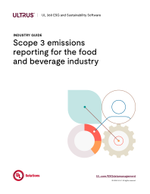
Scope 3 emissions reporting for the food and beverage industry
Discover the challenges, opportunities and developments food and beverage companies must consider when working to calculate, report and reduce their scope 3 greenhouse gas (GHG) emissions.

The food and beverage industry faces enormous pressure to run more sustainable and transparent business operations. After all, the food and beverage industry contributes up to 37% of global annual greenhouse gas (GHG) emissions. Both internal and external stakeholders are on board. In response to a September 2020 survey of business leaders, employees and consumers conducted by Edelman Data x Intelligence on behalf of The Nature Conservancy (TNC), 55% of food and beverage industry leader respondents reported increased investments in sustainability processes, and consumer respondents even expressed their willingness to pay higher food and beverage prices to support the industry’s sustainability efforts.
Until recently, companies have focused on reporting scope 1 emissions — direct emissions from sources that a company owns or controls — and scope 2 emissions — indirect emissions from the off-site generation of electricity, steam, heating and cooling bought and consumed by the company. However, now a greater emphasis is placed on scope 3 emissions reporting — which includes all other indirect emissions occurring in a company’s upstream and downstream value chain. This often accounts for more than 70% of the food and beverage industry’s emissions.
Calculating, reporting and reducing scope 3 emissions is no easy feat for the food and beverage industry, but UL Solutions experts are here to help. Read our guide to gain a better understanding of the challenges and opportunities food and beverage companies must consider as they embark on their scope 3 emissions reporting journeys.

Scope 3 emissions reporting for the food and beverage industry
Thanks for your interest in our products and services. Let's collect some information so we can connect you with the right person.